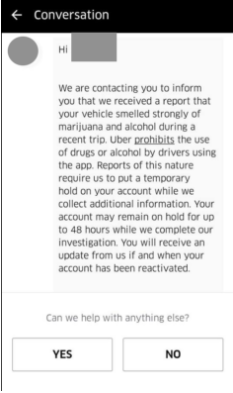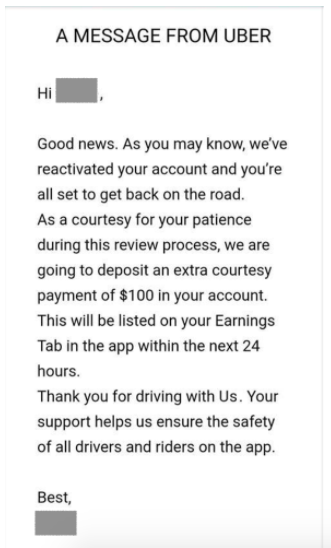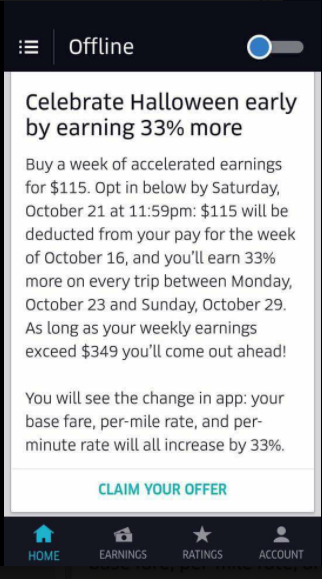The Network Uber Drivers Built
Cole* is a part-time Uber driver in Atlanta. On his first week on the job, he finds himself driving a passenger who has clearly had too many drinks. The passenger, a new arrival to the city, wants to know what to do and where to go, so Cole informs him of several tourist destinations.
“Out of nowhere,” Cole recounts, “he yells at the top of his lungs and slams his hands on my dashboard. ‘Dude, shut the F-up. Seriously, just shut the F-up or I’m going to have to hurt you.’
Stunned at the sudden outburst, Cole finds his bearings and quietly adjusts his hands on the wheel, careful to keep them loose in case he needs to ward off his aggressive passenger. They ride on in silence. A little while later, Cole’s passenger asks if he can smoke in the car. Hoping to appease him, Cole pulls over, so the stench doesn’t ruin his car interior—and possibly land him in trouble with a future ride. Each of them smokes a cigarette standing at opposite ends of the car.
When they arrive at their destination, Cole’s passenger invites him inside to smoke marijuana, and after he declines, suggests another cigarette instead. Feeling agitated at this early stage in his ride-hailing job, and eager to keep the peace, Cole doesn’t feel he can easily get out of this one.
“I didn’t know the Uber guidelines then,” says Cole. Company rules advise that riders who behave disrespectfully can lose access to the Uber platform. But even knowing the guidelines isn’t enough to negotiate all the exigencies of a ride-hailing job. “If I knew then what I know now, the second he got out of the car I would have driven off. But I didn’t know that. I didn’t know the kinds of repercussions at the time, having been only on it for a week.”
His passenger asked for a hug before Cole left, and it lasted too long. Drawing on the customer service skills he honed at his primary job, Cole brought his hand in front of his chest and gently broke the embrace.
Nearly a year after that first harried incident, Cole still drives for Uber, part-time. But he also wears another hat: He’s a forum administrator, one of many across the globe who put in countless hours managing unofficial online communities where drivers who work for Uber, Lyft, and other ride-hail services share advice and warnings, answer questions, and provide a rare sense of camaraderie.
“I didn’t create the group to learn something from somebody, but to get together with some people,” says Doberman, a driver who is also an administrator of a forum group for Uber and Lyft drivers in Louisiana. When I interviewed him, he emphasized that he’s trying to foster an environment where drivers can coach each other. “I want caring and more sharing when someone has a problem, not just to look over it.”
Ride-hail drivers at Uber and elsewhere have no way to speak with one another through the app. Instead, the forums—along with journalism, social media, and in-person conversations—are providing a vital source of information for workers trying to navigate a new set of labor practices. On these driver-led forums—on Facebook, on message boards, and on chat apps like WhatsApp or Zello—drivers are forging their own informal information networks, outside the algorithmically proscriptive realm of the ride-hail apps.
In early research on Uber’s drivers, my colleague Luke Stark and I found that an algorithmic manager communicates how they should behave and when and where they should work, using responsive incentives and penalties that affect their pay. While automated feedback may be effective for standardizing how hundreds of thousands of drivers behave, it doesn’t cover all the exigencies of this job, from safety threats to pay inequities. As Ricardo, a New York City driver who works for Uber, among other ride-hail companies, puts it, “You don’t have a boss over your head—you have a phone over your head.”
For over three years, I’ve researched the ride-hail world primarily through the perspectives of ride-hail drivers. As a technology ethnographer, writer, and researcher, I’ve joined driver forums, interviewed over 100 drivers, and made observations with over 400 drivers on the road across 25 cities in the U.S. and Canada. For many of them, learning the basics of driving for Uber is only a fraction of the knowledge work they do on these forums. Drivers have used these online discussion groups to crowdsource information on new pricing schemes, to dissect companies’ policies, to commiserate over bad passengers, to compare wages and ratings, and even identify incidents of potential wage theft.

In one instance earlier this year, Uber drivers used forums to suss out and debate a new policy the company was testing months before it became official. Passengers were being charged a higher fare than drivers were being paid, in a controversial pricing scheme that Uber calls “up-front pricing”: The company charges riders when they book a ride by guessing what a trip will cost, but it calculates a driver’s pay based on the actual miles and minutes they drive. That means that a driver may earn a little over $30 even when a rider pays over $90 for a ride.
Drivers learned of the scheme in part by comparing screenshots of their passengers’ in-app receipts with their own wages, and these comparisons spread through forums and public blogs, such as The Rideshare Guy. Despite criticisms that the policy was unfair to both drivers and passengers , Uber made it official in May. Late last year, Lyft quietly adopted a similar practice, and is now facing a lawsuit over deceptive pricing practices.
With many app screenshots of their work proliferating across forums, driver-to-driver comparisons spread across a disaggregated workforce from diverse cities, fueling a pervasive sense of disparity and suspicions of unfairness. At an individual level, some of the Uber and Lyft drivers I interview shrug off pay discrepancies; others are disturbed by them. But the group dynamics of online forums build off of a common sense of the inequities that affect all drivers.
These dynamics can emerge closer to home, too. Cole’s fiancée, for example, occasionally drives for Uber when she’s not at school or at home with their newborn son. When I interviewed him, he noted that she receives better wage promotions than he does because her driving schedule is more sporadic. Although he is more reliable, he said the company seems to work harder to retain her, which strikes him as unfair.

It’s not clear how many drivers participate in driver-led web forums and chatrooms, but they boast at least hundreds of thousands of members tallied together, covering local, national, and international regions (though there’s no guarantee that all members are, in fact, humans or drivers). Many of the forums have developed membership requirements and gatekeeping processes over time, so they aren’t technically open to the public. (In the U.S., Lyft has about 700,000 active drivers, and Uber has about 750,000 active drivers, though they define “active” differently.) Often, drivers work for both companies, and even when drivers start Uber-focused forums, these quickly expand to include members who work for multiple employers.
Drivers I speak with in person are often familiar with the online forums, though only a minority of the ride-hail driver workforce may be active in them—and many of them are simply readers. And even for drivers who have never used them, forums can shape their workplace: Online driver discussions influence how the media reports on their work, which offers more visibility and transparency to drivers. For instance, in July, the New York Times found that Uber allegedly deducted hundreds of millions of dollars inappropriately from drivers’ paychecks through faulty tax calculations; the New York-based Independent Drivers Guild alleged that Lyft engages in a similar practice. As it circulated among drivers both inside and outside of forums, the reporting validated a much longer institutional memory of pay frustration.
Although they often surface drivers’ concerns about ride-hail work for a wider public, forums are primarily sites of communication for routine workplace matters. (One common piece of advice I find in driver forums says that drivers should refrain from reporting to Uber or Lyft when they have a fender-bender or any kind of light vehicle incident, like a scratch: drivers risk deactivation if they do.) And not all of the discussions on driver forums center on the challenges drivers face; much of it is also positive, with appreciation for high ratings, complimentary passenger feedback, profitable trips, and the occasional on-the-job humor.
Still, rate cuts, commission hikes, and pay inequities often blend together on forums into a sustained current of resentment. And when a driver who sees that what happens to them is happening to other people too, it creates a broader framework for how they understand their workplace environment.

Drivers I’ve spoken with outside of forums highlight a range of concerns that mirror forum discussions, too. Amadi, an Uber and Lyft driver in Washington, D.C., shows me the ashy mark a passenger left on his car leather by putting out a marijuana blunt on the back of his armrest. The next passenger he picked up that day reported him to his employer for being under the influence, and he was immediately deactivated for a period of time, pending an investigation. (Uber, Lyft, and their stakeholders debate the impact of their services on reducing drunk driving, but there are spillover effects for drivers who work with intoxicated passengers in general.) Online, Uber and Lyft drivers share the “nastygrams ” they get from their employers after such misunderstandings.
Dash-cam footage—which drivers increasingly use to protect themselves from both traffic incidents and bad-behaving passengers—also circulates through forums, offering drivers cautionary tales and sometimes easy laughs. Recently, a Dallas prosecutor lost her job after an Uber driver recorded the threats she made against him. These channels of visibility, which are amplified by the media’s interest in Uber, reveal the uneasy accountability that drivers forge to protect themselves and their jobs.
Bit By Bit, Loosening An Uber Grip On Information
For years, Uber drivers’ primary point of communication with the company was Uber Support, an email-based customer service with agents who often work remotely, such as in the Philippines. When drivers like Amadi or Cole make inquiries or complaints, they often receive rote auto replies that are more responsive to keywords in the driver’s message than to the nuance or details of their particular circumstances. (Lyft has a mentorship program in select cities, which gives drivers another communication point.)
Changes are in the works, and drivers evaluate them in forums too. Over the last six months or so, Uber and Lyft started offering a phone number drivers can call, and developed in-person driver hubs in select cities. And recently, Uber added a feature for drivers to give Uber feedback at any time in the app. Uber is also forming a Driver Advisory Forum and Lyft has plans for select employees to get behind the wheel in order to become more sensitive to driver concerns.

In a job where the conditions of work are subject to frequent changes, partial information about a discrete experiment, an emergent pricing policy, or a test feature can spread quickly. For instance, last year one Uber driver who was wrongly suspended from the platform received a “reactivation” message from the company offering an unusual $100 courtesy payment to compensate them for lost income. By helping to spread a message like this—intended only for certain drivers or certain cities—driver networks disrupt the way information tends to flow on a platform like Uber.
In another recent example, Uber and two academic collaborators engaged in a two-city, economics research experiment with drivers who opted into it. But eventually, a screenshot from one of the drivers participating in the experiment—showing how Uber was charging select drivers to work at a premium through a promotional Halloween offer—became visible to non-study participants across the country, thanks to several forums.

Online, drivers debated how the conditions of this particular Halloween offer would affect the local conditions of their work, such as surge pricing. As it spread through forums, driver responses were mixed. Some cautioned other drivers not to fall for it, as though it was a trick for Uber to profit directly from drivers, or even a type of spam. A few noted that the offer was a gamble specifically because Uber controls which rides drivers get. After I blogged about it in October, news stories about the experiment helped spark a conversation among a larger public about labor fairness.
Forums also present other challenges for ride-hailing companies as they try to manage the spread of information. In forums, drivers post new updates every minute about their experiences on the road and in the app. Over time, I’ve seen forums become more porous spaces, with certain posts becoming news articles days later. As a steady stream of articles about Uber and occasionally Lyft circulate among drivers on forums, that reporting flows to drivers outside of forums, too.
Kofi, an Uber and Lyft driver I interviewed in Washington, D.C., was appalled when he learned first from the media last month—rather than directly from his employer—that hackers had gained access to his personal data and that of 57 million Uber drivers and passengers from around the world last year, such as their names, email addresses, and mobile phone numbers. In the U.S. alone, 600,000 drivers were affected by the hack, which compromised their drivers license information. Uber, which had paid the hacker a “bounty” to delete the data and keep quiet about the breach, later notified drivers by snail mail and email on November 22, 2017, a day after Bloomberg first reported it. Before moving to the U.S., Kofi practiced law as an assistant attorney for a government agency in Ethiopia. “I expected Uber to do better when it comes to protecting private information, be it for customers or drivers,” he added.
Drivers also band together on forums and chat apps to protect themselves, not from the ride-hail platforms, but from local authorities. For example, in Montréal, Québec, where Uber drivers operated illegally before ride-hail work became legal, drivers showed me the Zello chats they used to update each other on the whereabouts of the transportation police, or hostile cab drivers in the legitimate workforce who tried to intimidate or even attack them.
The knowledge that percolates up from communication networks like these can buffer drivers against the instability of their jobs. By filling in gaps neglected by the platform economy, these informal driver networks also help make that instability more sustainable over time. As drivers like those in Québec band together to manage some of the risks associated with their employment, they are also, in effect, helping their employers as well.
Uber is uniquely public as a disruptive force in society, and the labor concerns that drivers map are amplified by Uber’s media spotlight. But online communications are adding a new dimension to other kinds of gig work too, as my colleagues at Data & Society, Julia Ticona and Alexandra Mateescu, have found in their research on care and cleaning platforms. Mateescu writes about Facebook nanny groups, where “caregivers keep an ear out for work, build their reputations, warn about bad employers, or participate in ‘nanny shaming,’ and importantly, discuss what a fair employment relationship looks like.”
By classifying drivers as Independent Contractors, managing them through algorithms, and automating communications, companies like Uber keep their workers at arms’ length and distant from each other. Employment trends, meanwhile, point to longer-term growth in the contingent workforce as more companies rely on sub-contracting arrangements. Online forums aren’t just helping drivers like Cole navigate the challenges of their work, and helping those of us who use and study these platforms grasp those challenges too. They show how as employment relationships grow more remote and distributed across the network, workers can adapt, using technology to forge their own workplace culture.
*All driver names have been changed to protect their anonymity.
Alex Rosenblat is the author of How Uber Plays Us All, forthcoming with the University of California Press in 2018. She is a technology ethnographer and an interdisciplinary scholar who works as a researcher and technical writer at the Data & Society Research Institute. Follow her at @mawnikr.
Fast Company , Read Full Story
(40)














